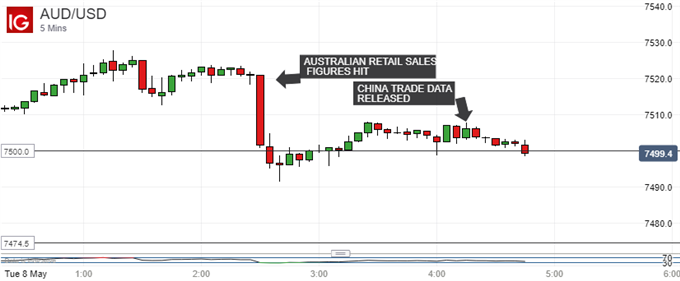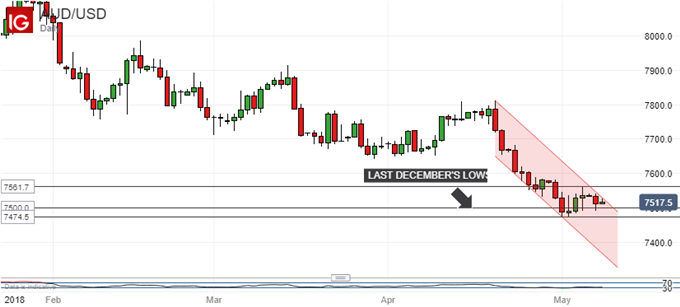
CHINA TRADE DATA, AUSTRALIAN DOLLAR TALKING POINTS:
- China’s trade surplus ran ahead of expectations for last month
- Imports and exports both surged, despite rising trade tensions with the US
- The Australian Dollar seemed more focused on local matters
Find out what the #1 mistake that traders make is and how you can fix it!
An Australian Dollar already hit by much weaker-than-expected domestic retail sales figures failed to perk up much on news of robust Chinese trade for April.
The US Dollar-terms trade surplus was $28.8 billion over the month, composed of a 12.9% export surge and a 21.5% rise in imports- both hugely ahead of expectations. The Yuan-terms surplus was 182.8 billion, slightly below expectations but well above the previous month’s CNY29.8 billion deficit.
The data suggest that Chinese trade continues to expand hugely, despite the ongoing spat about its surplus with the US, and Washington’s worries about respect for intellectual property.
However US President Donald Trump’s threat of $150 billion of tariffs still hangs over China. They could be imposed after a consultation period which ends on May 22. Beijing has said it would respond with levies on US goods from soybeans to aircraft.
This prospect could be one reason why AUD/USD reacted so little to the numbers. The currency can act as the markets’ favorite liquid China proxy but the market may well have been too pre-occupied with local retail weakness on Tuesday. Consumers unwilling to spend will do little to increase the stubbornly torpid inflation levels which have for so long stayed the Reserve Bank of Australia’s hand when it comes to higher interest rates.
Trade talks between China and the US are set to resume in Washington DC next week.

On its broader, daily chart the Australian Dollar remains mired. The US Federal Reserve remains the major central bank regarded as having by far the most scope to tighten monetary policy. The RBA is seen to have very little. While the Fed is thought likely to raise interest rates yet again next month, the Australian central bank is not expected to make the first increase to its record-low 1.5% Official Cash Rate until well into 2019.
The Aussie economy is by no means performing poorly, but it is performing patchily and inflation remains stubbornly low. AUD/USD is back into a clear downtrend channel. The lows of last December continue to provide some support but it is difficult to see them holding unless global markets have a general rethink about US Dollar strength.

RESOURCES FOR TRADERS
Whether you’re new to trading or an old hand DailyFX has plenty of resources to help you. There’s our trading sentiment indicator which shows you live how IG clients are positioned right now. We also hold educational and analytical webinars and offer trading guides, with one specifically aimed at those new to foreign exchange markets. There’s also a Bitcoin guide. Be sure to make the most of them all. They were written by our seasoned trading experts and they’re all free.
— Written by David Cottle, DailyFX Research
Follow David on Twitter@DavidCottleFX or use the Comments section below to get in touch!